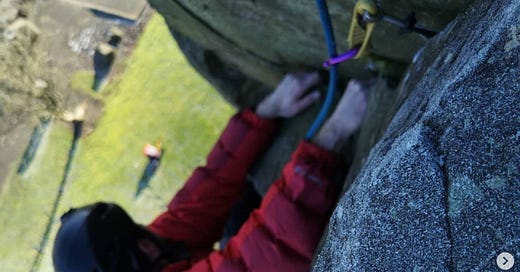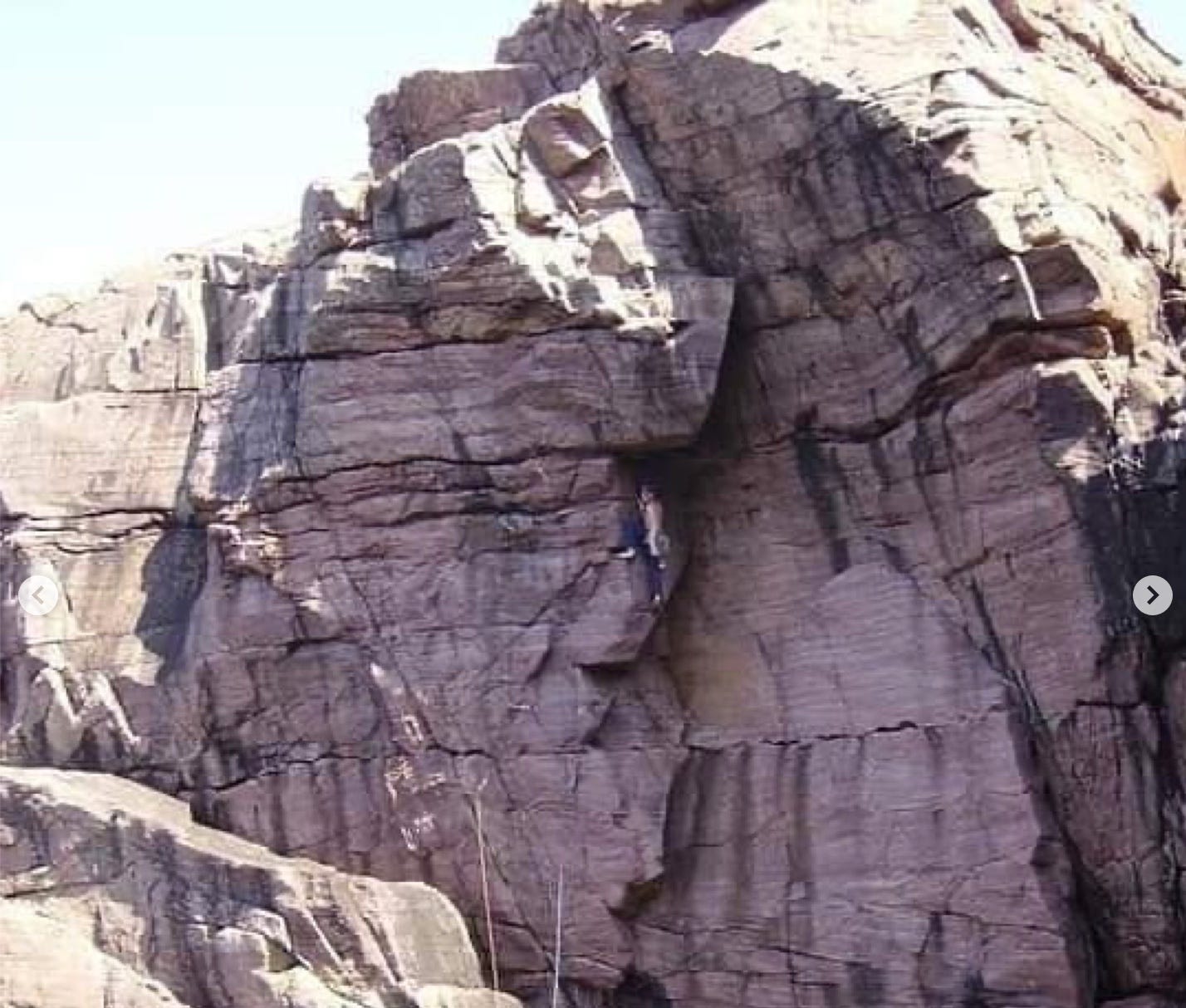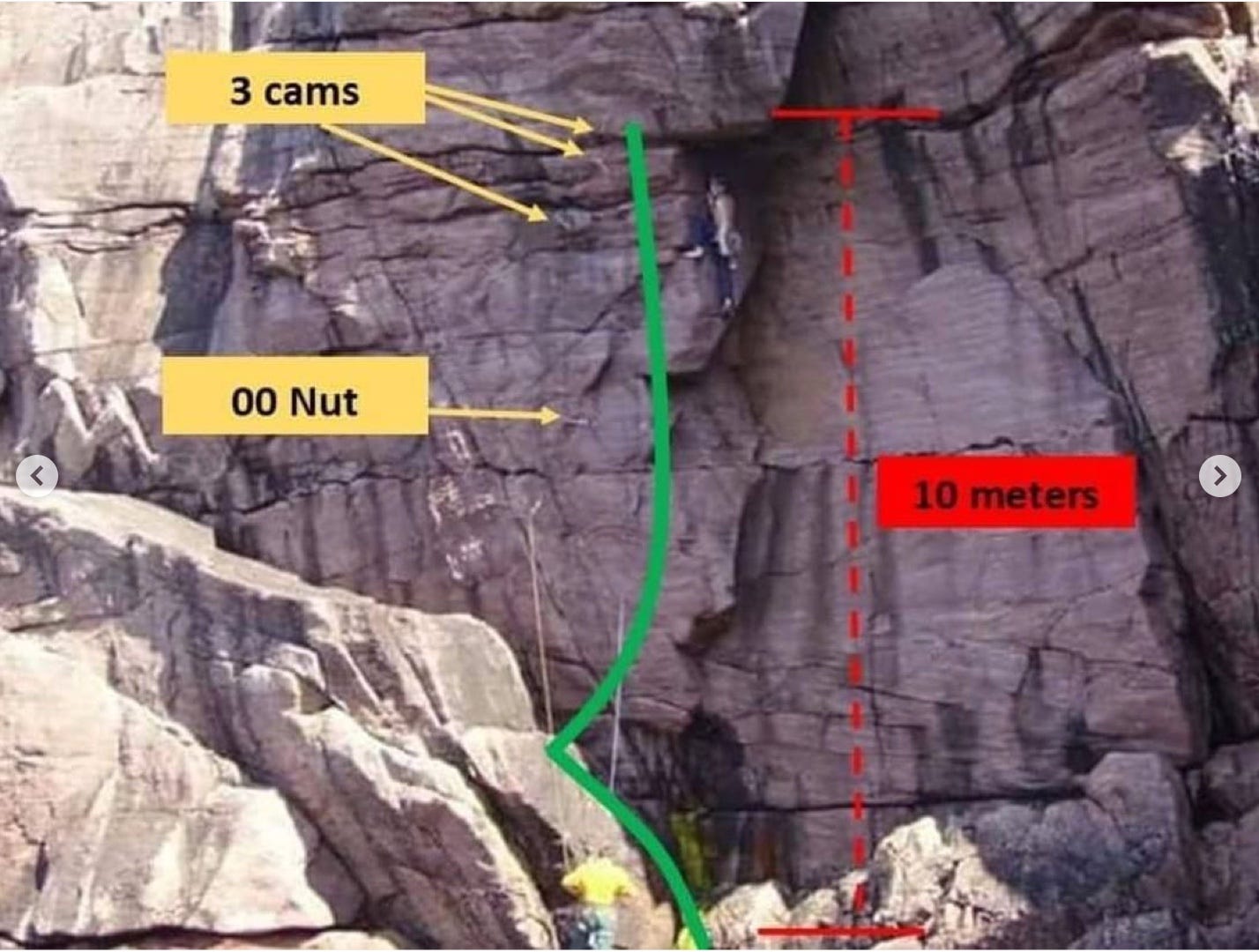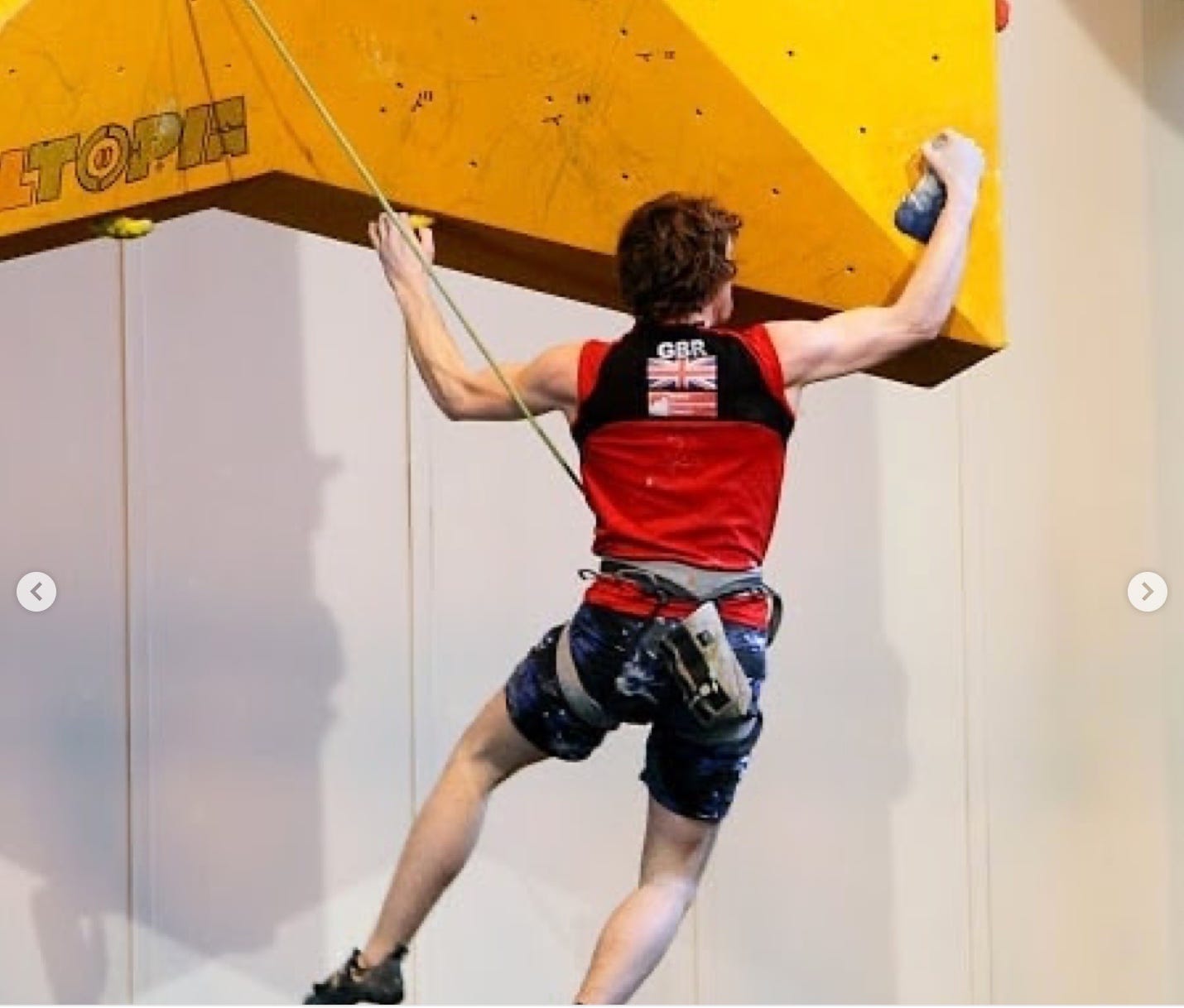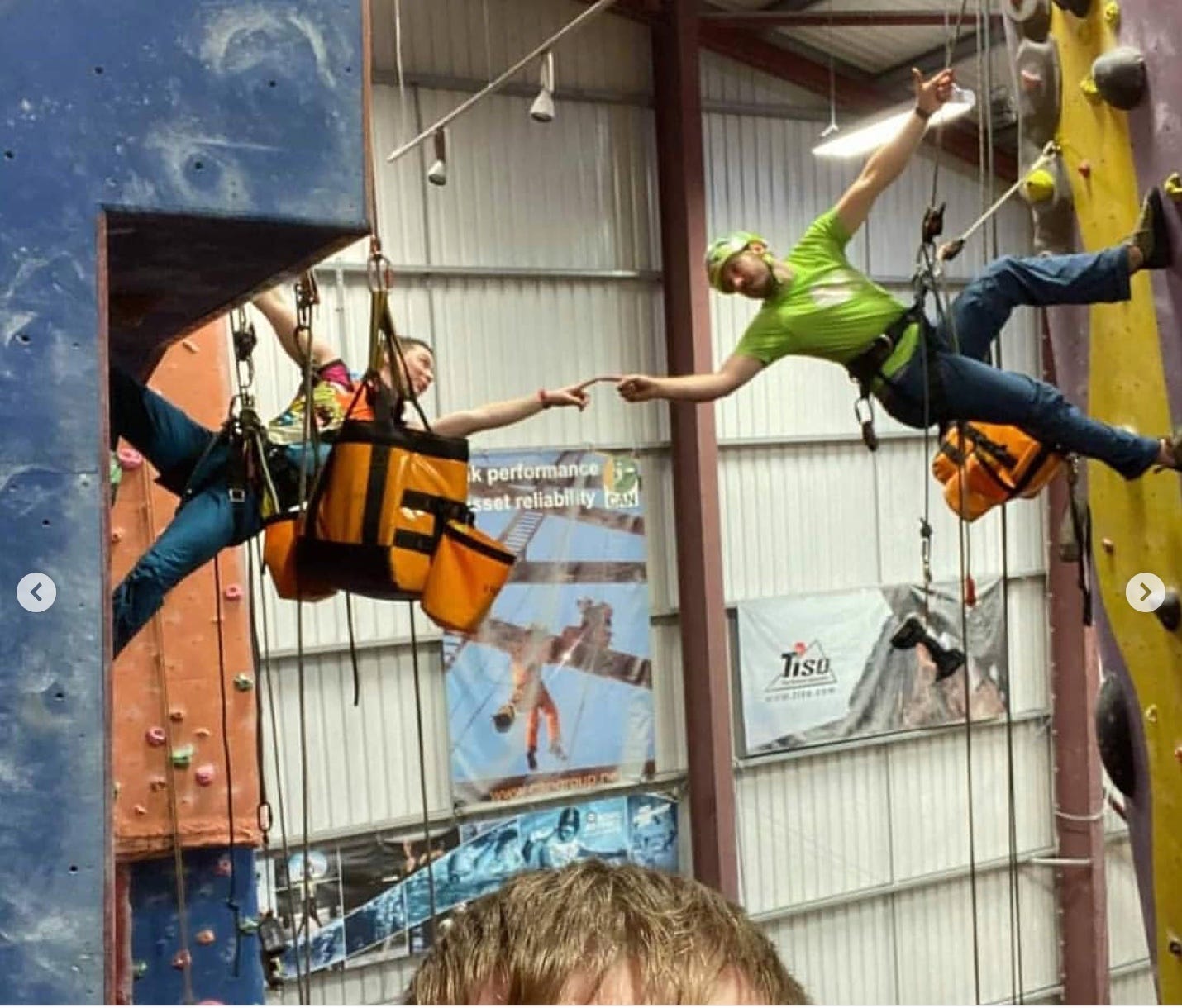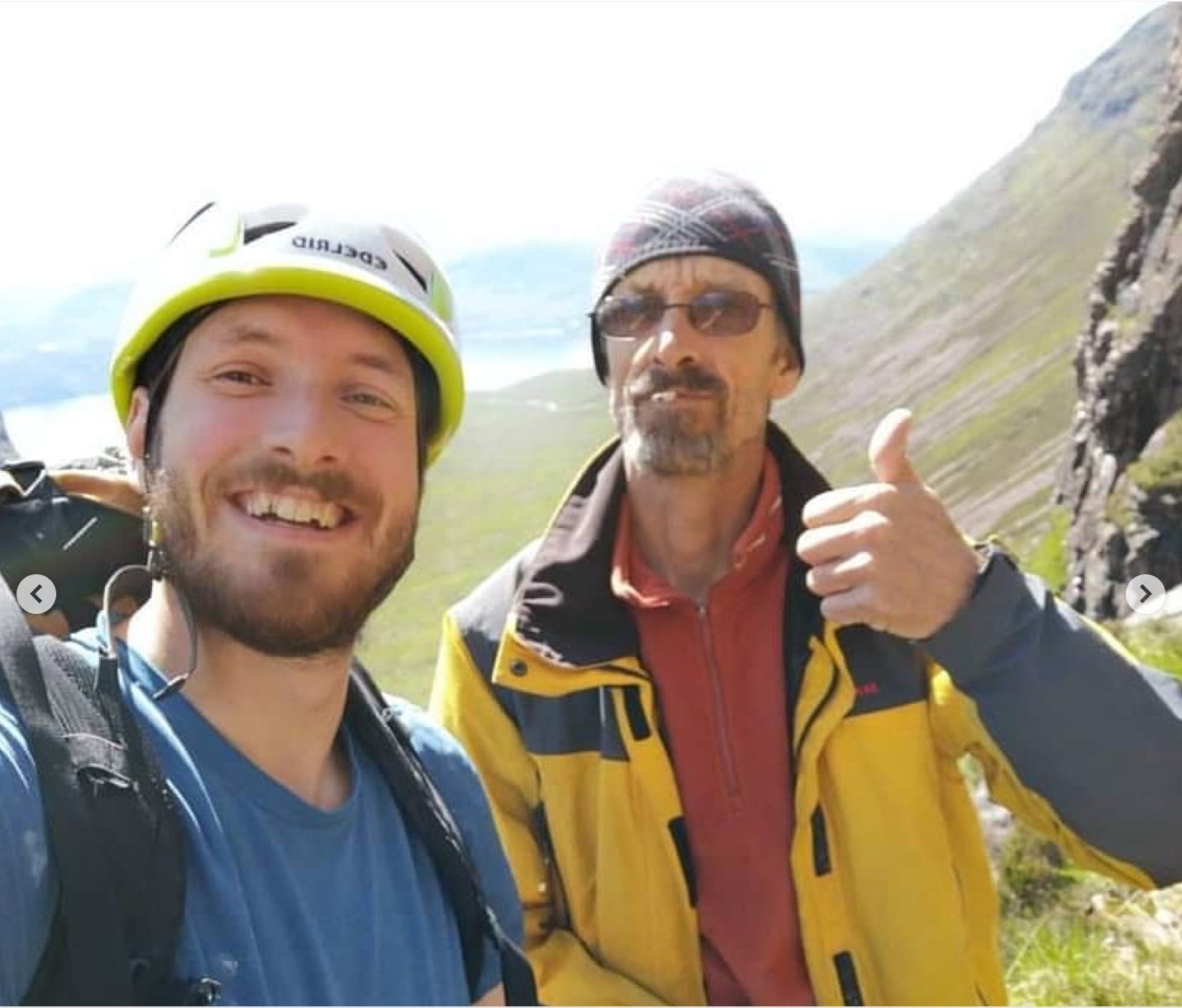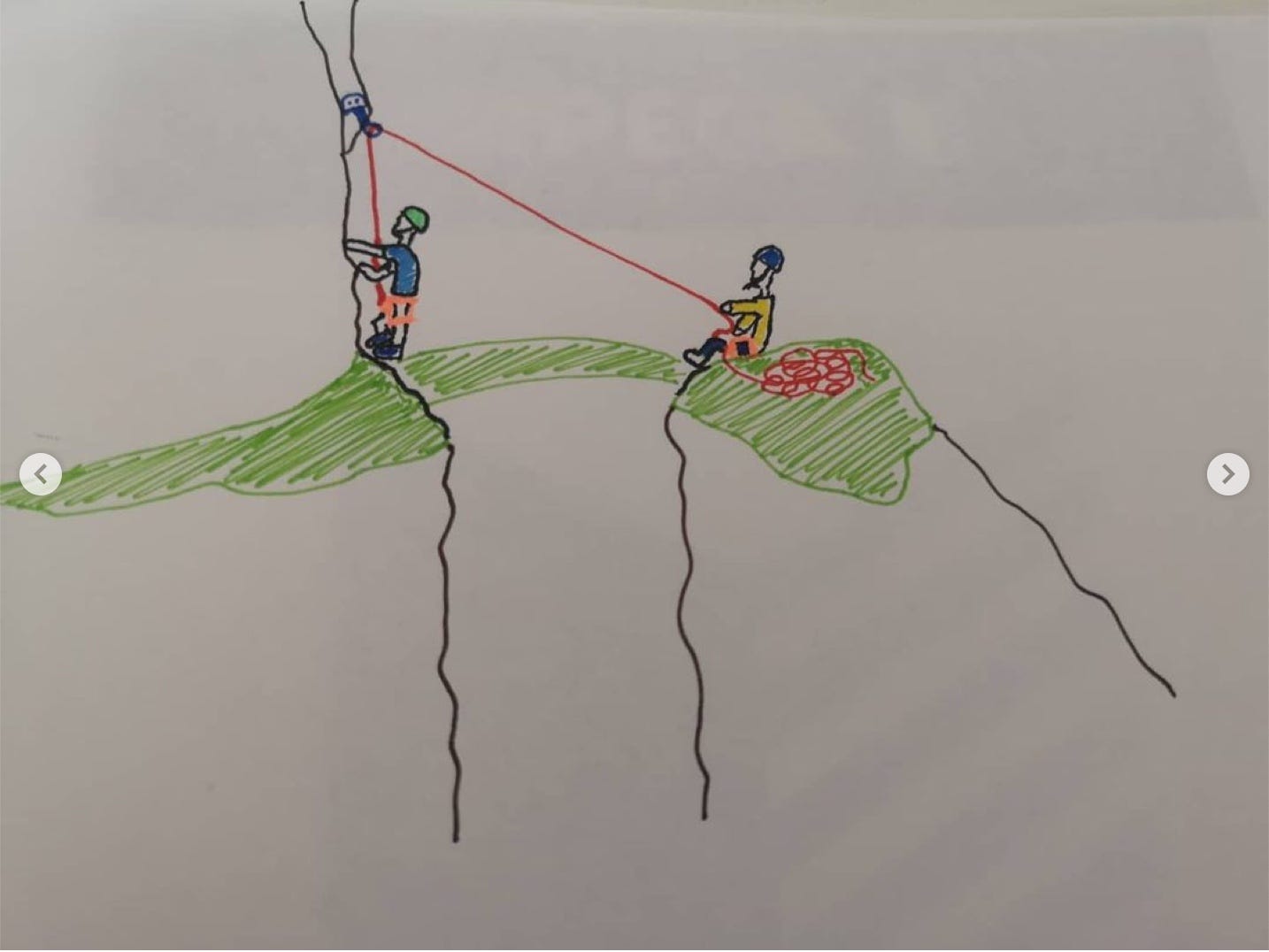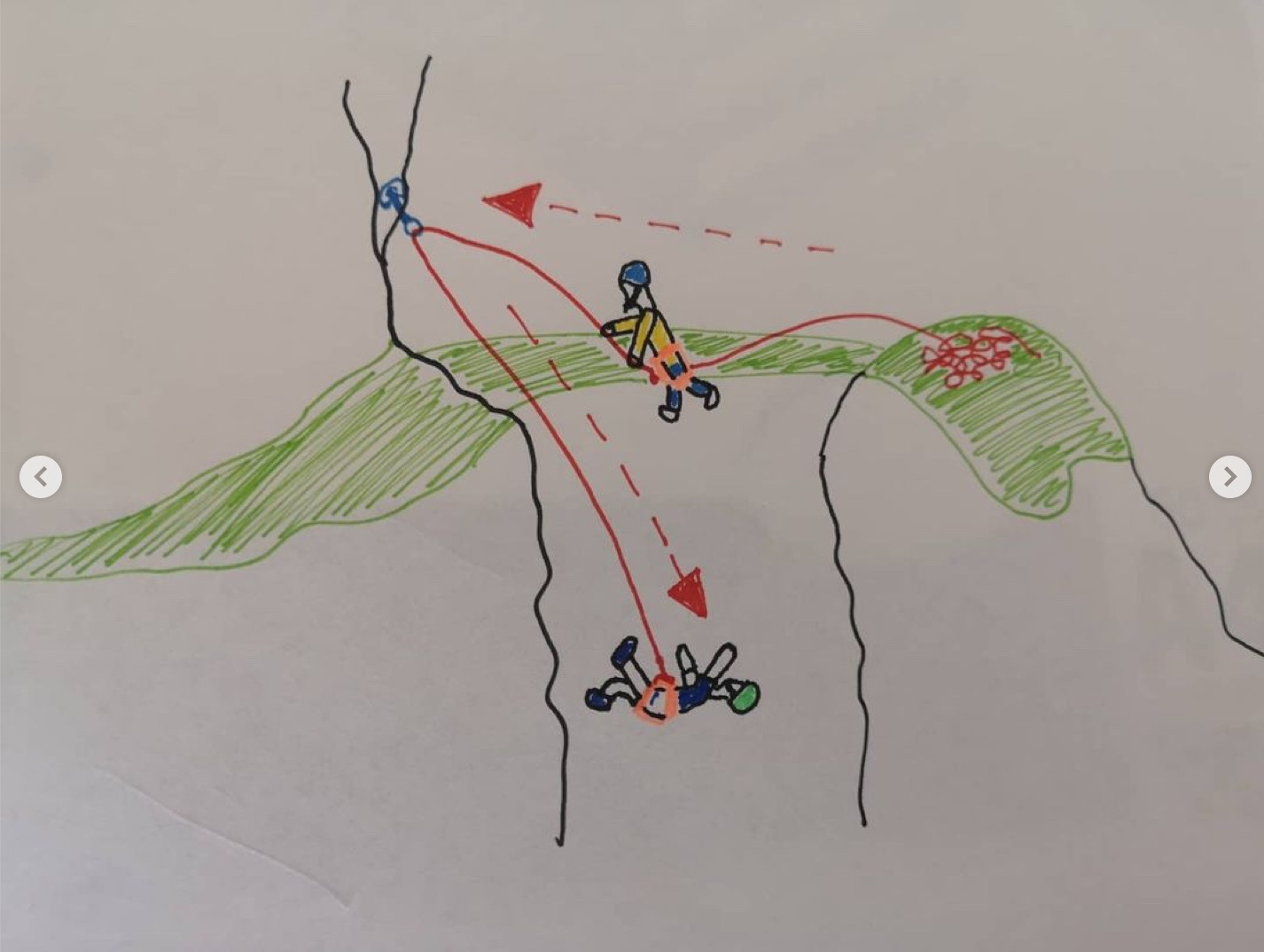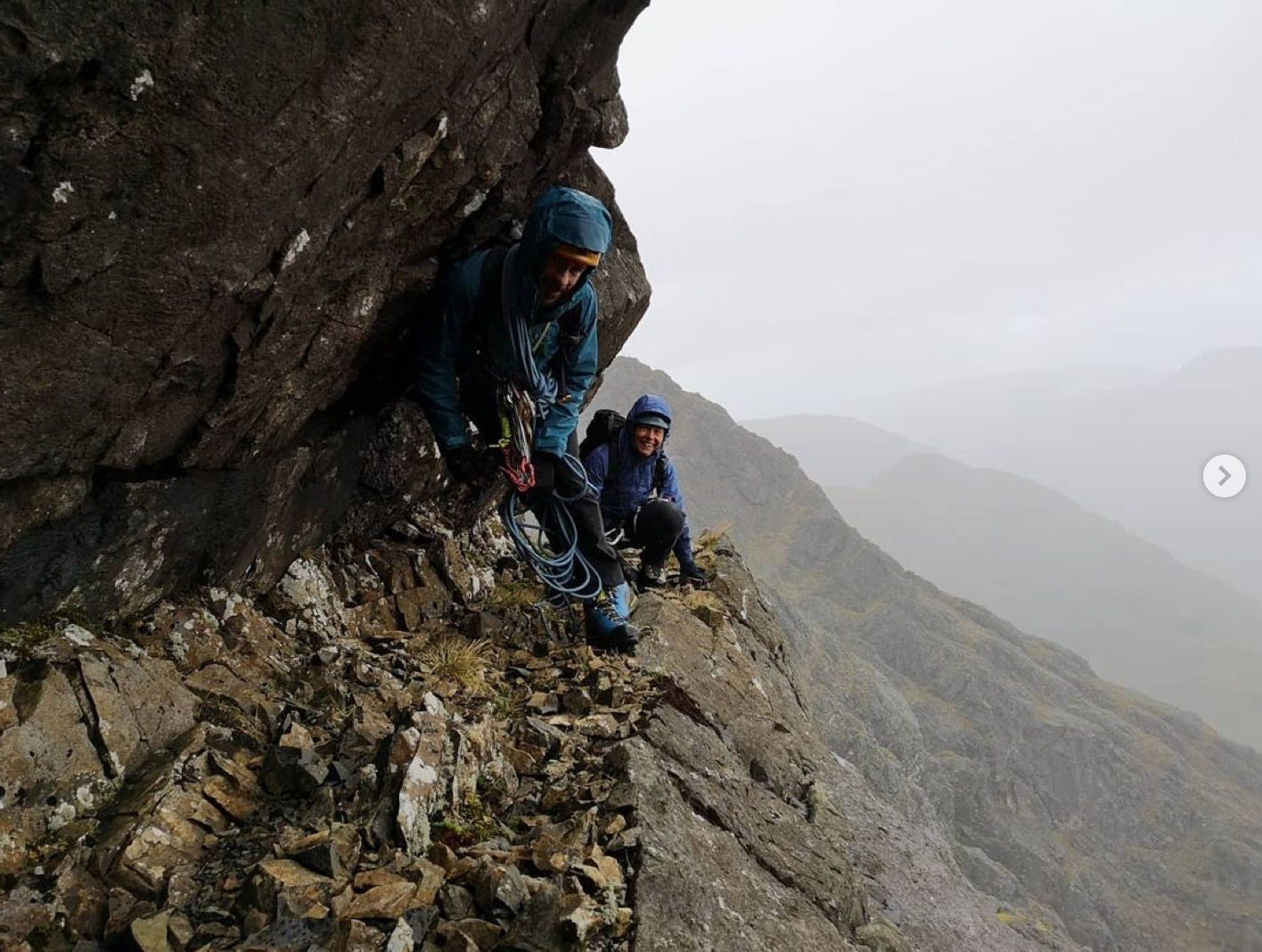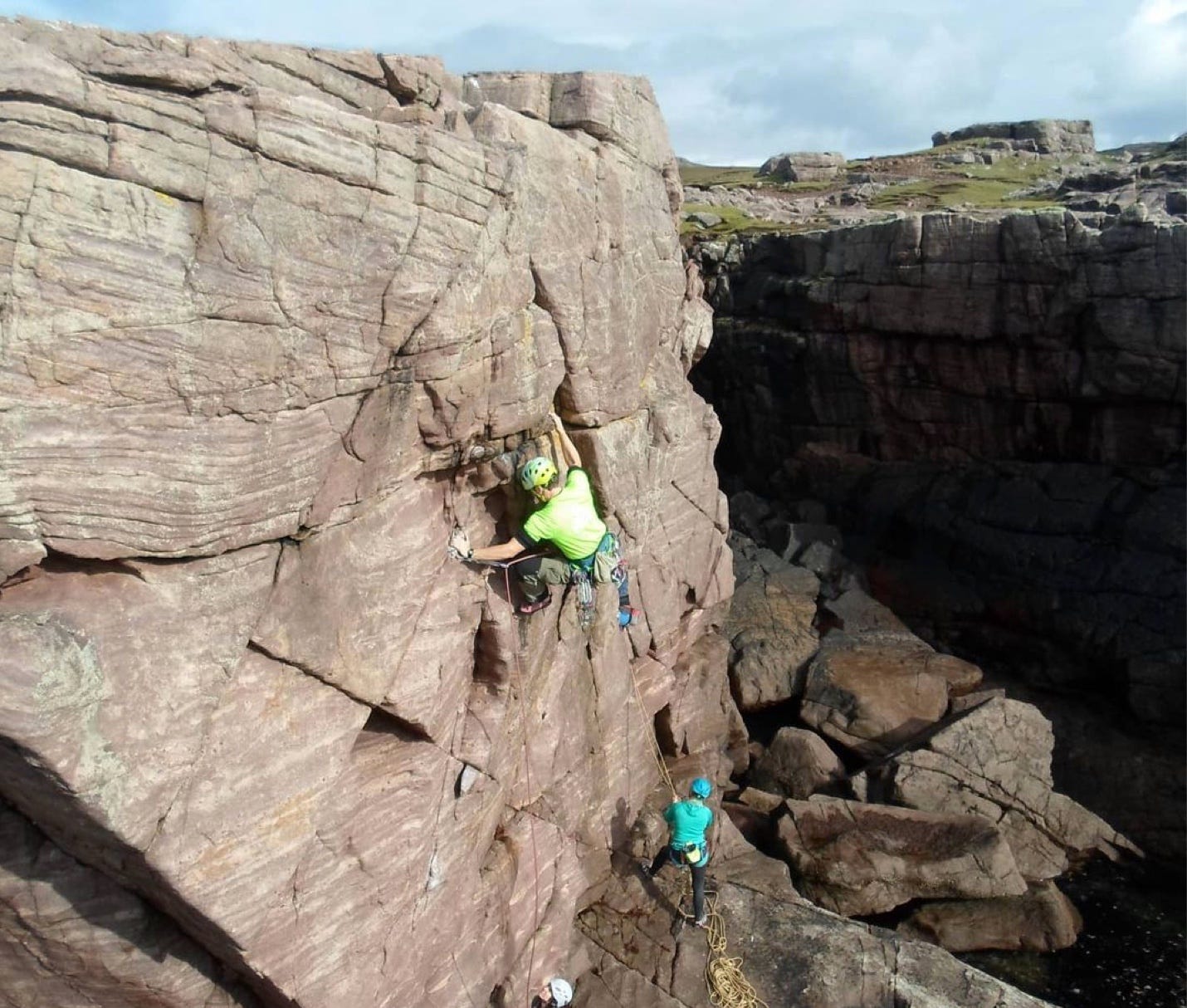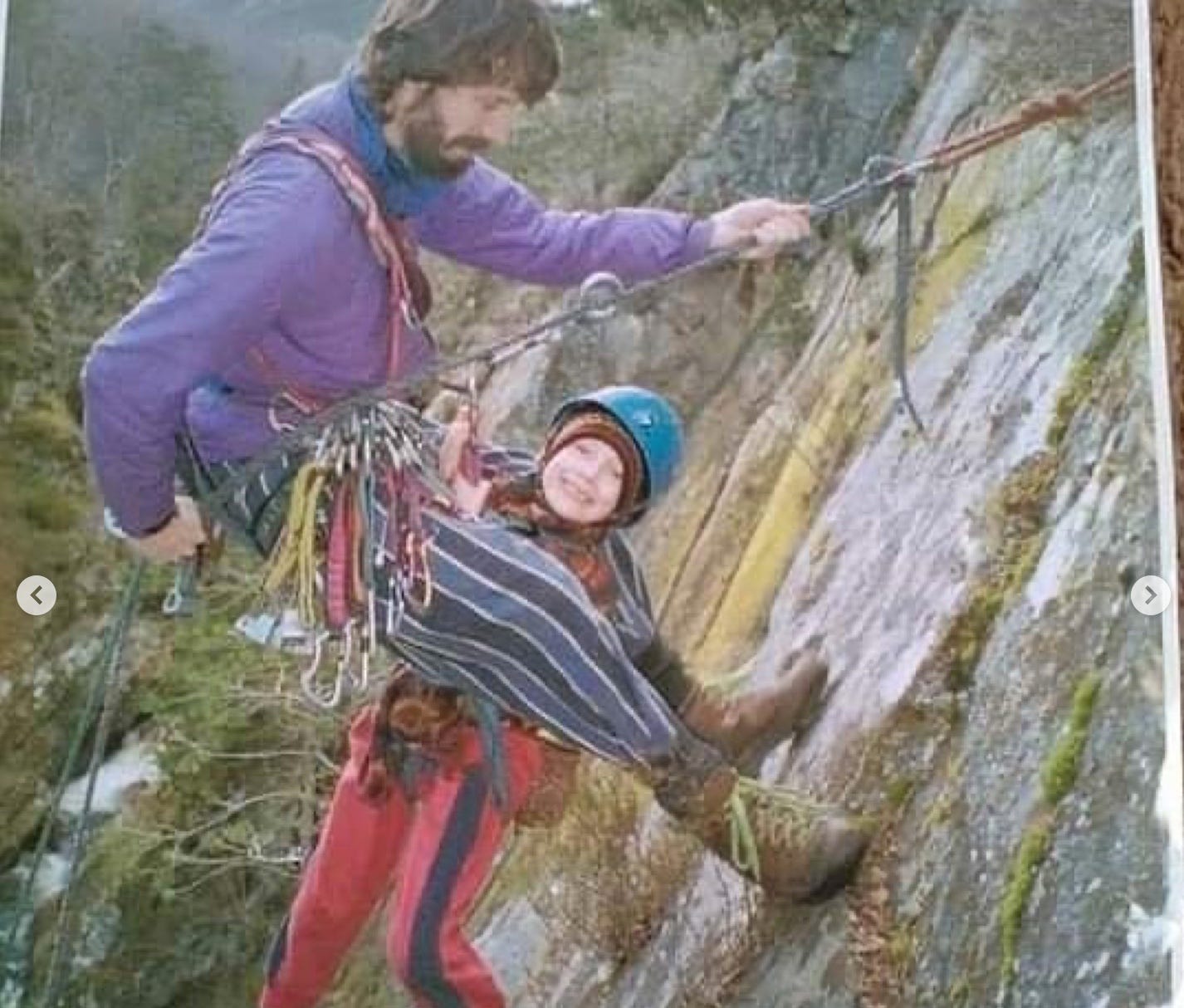A month ago I started the ‘Oh Shit Award’, an award given to climbers who are honest and share their mistakes with a wide audience (just include the hashtag #ohshitaward so I can find it). I’ve also had a lot of people DM me and I will share some more next week, but this months winner is Scottish climber Robert MacKenzie (@skampervan.adventures), who gets both an A for effort, as well as a W for ‘Well done on not dying!’.
#1. Anchors in loose blocks
@shirewalksuk and I went to a small crag near Glasgow last year, with the intention of not doing anything intense, so I only brought a 30m rope. We then got too psyched and wanted to go round to an area that required an abseil in. The only problem was the rope was too short for a full ab so we did it as 2 pitches. I abseiled in first, rigged and anchor then Scott came to join me. We then pulled the rope and set up for the next abseil.
The anchor was a shallow but OK cam and a size 1 nut deep in a crack that, upon testing, seemed 100%. But as poor Scott sat back on the ab rope and began his descent I watched in horror as that crack started widening and the nut started moving.
So I casually reached out and held the biner attached to the nut, braced myself and took the weight. Scott, completely unaware of the situation looked up at me and smiled, as I calmly stood there sunbathing. I held the weight till he was on the ground, then quickly removed the nut and replaced it with a bigger one. Lack of any other cracks forced me to reuse this one, but at least a bigger nut made me slightly more comfortable.
Lessons:
If you're going to do a route or ab in, make sure your rope is long enough.
If you're going to test some gear, test it properly. If I had I might have spotted that the crack wasn't as solid as I'd thought.
#2 Cleopatras Asp
A 15-year-old, way too cocky, and nieve, Robert took on the E5 6a of Cleopatras Asp, Reiff. The Asp proceeded to bite me in the Asp.
The route climbs the short ramp at the bottom before traversing out a horizontal break to the arete. Here you place the most marginal of 00 nuts, before taking on the Crux. A short boulder problem on a small crimp to gain the big double break (seen left of me in the photos).
I cruised through the Crux, gain the breaks and quickly threw in three cams. I then got stuck. I absolutely could not figure out the next move, how to get off the break. I traversed back and fore for about half an hour before the pump really set in.
I was committed, it was now or never. I saw a bulge above me and assumed that because I couldn’t see any other holds, that must be it, the only hold, just out of sight. I would have to throw for it. So I called my dad, belaying, that I was gonna have to dyno. I wound up, breathed, and exploded up. But to my horror, I slapped a completely flat wall.
I fell, my vision went black and all I aware of was feeling that horrible... ping, ping, ping, as my three cams ripping out. As I fell my leg went behind the rope and after about seven meters I weight that lone 00 nut, which held, long enough to flip me upside down and swing me hard into that small ramp at the based. Then it too ripped, and I bounced to the floor.
After some good poking and prodding by my father and a fellow climber who I think was a doctor, they determined that I wasn't broken, just severely bruised. So dazed I stood up and together we hobbled the two miles back to the car.
I was lucky, extremely lucky. I didn't break anything but had quite a lot of bruising for a while. I hit the slab upside down, but perfectly parallel so it spread my weight enough to take a lot of the force out. I was lucky.
A 00 nut saved me.
Lesson
Complacency is the killer - I was too overconfident with my skills (by this point with 12 years experience) and obviously didn't check those cams were bomber. I can't even remember looking at them. ALWAYS CHECK YOUR GEAR!
#3 - Competition Climbing
It's generally considered (wrongly) that indoor climbing is safe, and competition climbing is no exception. I competed for over a decade in national competitions, and 6 years competing internationally on the GB team. But this is definitely the scariest moment I had in those years.
While competing in a national comp in Wales, I was on a mega route that went through this big roof section. I wasn't new to leading but I hadn't led through such a big roof before. This is a moment we have all come across.
As I started through the roof, I reached out to see if I could clip the next draw. Obviously a bit scared of climbing too far without a draw clipped, I wanted to clip as soon as possible. So I took as big a loop of rope as I could, I reached out to try and get that next draw. The hold I was holding wasn't great and as I reached out I felt my grip fading and I panicked and let go of the rope so I could grab the wall. Here started the problem.
As I got both hands back on the wall, the rope fell in a weird way and ended up wrapped around my neck!
The room went silent, the only noise was me going "oh oh". I realised I couldn't hang on the bad holds long enough to free myself and a fall would be... Bad!
I looked for a safe hold to stop at, but I couldn't climb down and the next jug was a few moves off. I committed 3 more moves to the nearest jug, a refuge to be able to get the rope off my neck before clipping the draw. Thank F***!
Lessons:
Clipping the next draw as soon as you can reach it, for a few reasons, isn't the safest option. You’re better to climb till you’re beside the bolt to clip.
Taking huge loops of slack doesn't help. You only need one arm length if slack maximum. Taking a loop of slack, putting it in your mouth, and taking another is dangerous.
Always apologise to your belayer after nearly causing them a heart attack
#4 - route setting
Relatively early in my route setting career, I was setting some absolute classics for one of our youth competitions. I honestly can't remember what comp it was, or what climbing wall I was in... Honest.
But as is common on these national competition setting days, we have an awesome team of setters from all over Scotland. Friends we haven't seen in a while and always the best of banter. And here we have the problem.
On this particular occasion, I was setting my final route of the day, energy levels were low, mental capacity lower and banter had descended into ridiculous. We route setter use, Rig (big beefy Gri-Gri type thing) on the main rope and a shunt back up on a separate rope.
We were all having such a laugh as I connected all my ropes and buckets full of holds ready to jug up the lines to the top. I left the floor and quickly jugged my way up the 10m line.
As I reached the top I relaxed to start hauling my holds up, and I heard a... Click!
I glanced down and notice that my Rig, wasn't closed. There was nothing stopping the device from opening and the rope from coming out. Just sheer dumb luck that it didn't.
I closed it quickly and never spoke of it until now.
Lessons
Doubled check, buddy check all your equipment is connected properly before you leave the floor!!!
Don't allow yourself to get distracted while connecting your equipment. Shut up, do the job, then talk
#6 - Should have seen it coming
It's been a while since me and my dad @ruairidhmackenzie managed to get climbing together. So this day in Applecross was long overdue.
At the based of the route, the grass ledge was about 1/2 a meter wide and at a 45-degree angle. Below this was a short 2m wide gully. My dad, being the leisurely climber that he is, refuses to be uncomfortable at a crag, so opted to belay from the other side of the gully instead of perched on the ledge. So as I scrambled around the gully to the base of the route I threw in a bomber cam.
Now my father is a very old school climber, so naturally just as I was about to start he shouted "wait, I want to roll a cigarette first"
So he reached into his bag and pulled out a tobacco pouch, which he immediately dropped. It rolled down the hillside a while before stopping, 'just' within a rope length. We decided instead of rigging an abseil, seeing as I was already on belay with a bomber cam in, I could be lowered down to it.
Guessed what's about to happen?
Yeah, as I sat back the physics of our positions and the fact that I'm a wee bit heavier than he is, made the situation escalate.
I sat back and realised I was being "lowered" a lot faster than I was expecting. I was being dropped into the gully. Confused as to how this was happening I looked up in a panic and saw my poor father being launched from his perch across the gully and hard into the other side.
As we both came to a stop, we both burst out laughing because 2 rather experienced people should have seen what was about to happen a mile off.
Lesson:
You need to take into consideration the difference in weight between climber and belayer. A lighter belayer can be lifted off the floor and if they aren't expecting it, could drop you. There are ways of protecting against that. The Ohm twists in the rope, heavier belayer.
Only the best belayers take dirt to the face before letting go of the dead rope!
If your father drops his tobacco pouch. Make him go get it.
When the MacKenzies get together it's a bloody riot
There is a time to concentrate
#7 - geological time includes now
One of my favourite people in the world @mountainhannahfrancis had her 30th tucked away in a wee bothy with a couple of friends and her mum (Claire) and stepdad (Daj). We all made plans to do some crazy adventures, but this one day I was the only one left to join Hannah her family on the incredible Clach Glas Traverse.
This kilometre-long wild ridgeline traverses across to Blabheinn, finishing up a super cool horizontal chimney shuffle. The weather was slightly moist and windy but I'd added to the intense atmosphere of where we were. This is hands down one of the best scrambles I've ever done and I'd highly recommend it.
Just don't do what I did next.
While mid-way along this horizontal chimney shuffle I looked back at Clare and Daj. The view of them perched on this tiny ledge and the view behind them was stunning. What an amazing photo it would be (photo 1). But to get the perfect angle I needed to lean out just a little.
Not being a complete moron I didn't just lean out above a very deep and dark gully. I found a small but positive crimp and used that to support my manoeuvre.
Just as I clicked the button to take the first photo... Ping!
The crimp exploded of the mountain and passed my face as I just, and I mean JUST, managed to stay in balance. I slowly put the phone anyway, and nobody spoke of it again.
Lessons:
Loose rock is Always a risk, especially in the mountains. Never 100% trust your life to a single hold without first testing it's solidness.
Some photos are best left as a mental picture. They aren't worth risking your life for.
#8 - which end does the belay go on
We were climbing out at Reiff. My absolute favourite place for single pitch climbing in Scotland.
I can remember what route we were on but the leader cruised as always as I belayed relaxed in the summer sun.
The climber reached the top, built a pretty bomber belay, hauled the ropes up, connected the belay device and made the call.
"climb when ready"
It wasn't an easy route. Kind of off-balance at times and easy to mess up. But I made it, no mistakes and pulled over the top.
Only then did I realise that my belayer had attached the belay device to the wrong end of the rope! There was at least 30m of rope between me and the belay device so if I had fallen, it would have been free fall to the platform below.
Lessons:
1. Double check your set up before letting your partner start climbing. Make sure that everything is where it should be.
2. If something doesn't feel right, like no matter how much you belay you never seem to be taking in all the slack, stop and fix the problem. Don't just carry on regardless.
3. Never assume that you can fall off and it'll all be OK.
#9 - be good to use the anchor eh
We were climbing up at the Scatwell Slabs (River Slabs). These slabs are 70-80ft of smooth flat Schist with huge never-ending flakes and loads of exposure. The slabs run into a deep gorge to meet a pool that said to be 70ft deep.
It's a spectacular place to be when you're a young kid (me and my dad pictured above when I was maybe 7 or 8)
This day though I was around 15, my climbing partner had led the Joust. A spectacular flake line that ends in two huge and really of balance mantles in litter box sized slots.
After a good fight they topped out and I quickly followed. I've done this route a million times so ran up the flake however still needed to take my time on the mantles so as jot to mess it up.
As I topped out, happy with climbing one of my favourite routes, I surveyed my belayer anchor.
Absolutely perfect 2 massive trees slung. The best set up you could hope for.
1 problem!
My belayer didn't attach themselves to the anchor! So if I had fallen off those last tricky moves, I would have dragged my belayer over the edge and we would both have tumbled down the 70ft slab into the pool below.
Lessons
Che and double-check. Before you or your partner leaves the floor absolutely check that everything is set up and connected properly.
If you're going to go to the hassle of building the perfect anchor, at least use it.
Never just assume its OK to fall off.
Follow Robert MacKenzie at @skampervan.adventures or listen to his podcast at www.scotrock.podbean.com.

